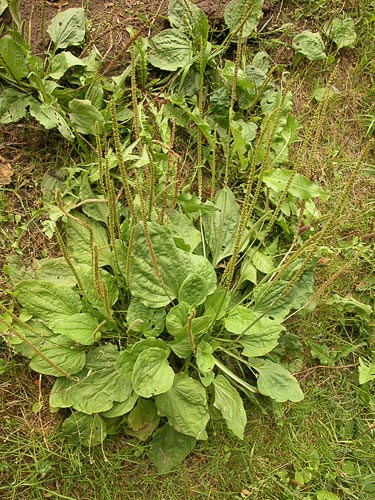Weeds
Plantago major L. - Broad-Leaved Plantain.
Systematic position.
Family Plantaginaceae, genus Plantago L.Biological group.
Perennial weed.Morphology and biology.
Plant is 10-70 cm tall, glabrous or slightly pubescent. Rhizome short. Stringy, coronal roots grow from rhizome. Leaves radical, petiolar. Their plate reaches 12 cm in length, widely ovoid or elliptical, full, less often indistinctly serrated on the lower part, glabrous (less often slightly pubescent), with three to seven arcuate ribs. Flower shoots ascending, finely striated, densely covered with small, sessile flowers with ovoid bracts at their base; the latter are glumaceous at the edges, usually shorter than sepals. 4 sepals are 1.5-2.5 mm in length. Corolla light brown, sympetalous, actinomorphic, with four lobes about 1 mm in length. Cylindrical tubule is formed in the lower part. 4 stamens with violet anthers are located on threads attached to tube of corolla; the threads are twice as long as the tube. Pistil has two-celled ovary. Fruit is an ovoid, multi-seeded (6 or more seeds) boll dehiscing along transverse sutures. Seeds flattened, angular, grayish brown or brown, 1-1.7 mm in length, with fine longitudinal rugosity. Propagation occurs by seeds. Weight of 1000 seeds is 0.14-0.25 g. Blossoming occurs from May until September. Fruits ripen from June until autumn. Seeds are spread by human clothes and containers. One plant can produce 61,000 (maximum 320,000) seeds. Seeds maintain their viability for 7 years and sprout from depths of no more than 3 cm. Minimum temperature for germination is +6-8°C; optimum temperature is +26-28°C.Distribution.
The European region of the former USSR (everywhere up until the Far North), the Caucasus, Western and Eastern Siberia, the Far East, Central Asia, Western Europe, India, the Himalayas, Iran, Mongolia, Japan, China, and North America.Ecology.
Grows among waste and abandoned places, near habitations, roads, and pasture meadows. Grows on various soils, depending on their mechanical structure and humus moisture content. In southern droughty areas, the Plantain is confined to river flood-lands. Found also among crops, especially frequent in kitchen gardens. It grows at altitudes as high as 2000-2500 m above sea level.Economic significance.
Infests summer grain crops, fallows, tilled cultures and perennial grasses. Control measures include stubbling, autumn plowing, and mowing of plants before fructification. Shallow soil treatments should be repeated after 10-14 days in order to exhaust roots. Apply herbicides, if necessary.Related references.
Chikov, P.S., ed. 1983. Atlas of areas and resources of herbs of the USSR. Moscow: VNIILR, BIN, LGU, TGU. 340 p. (In Russian)Filatovб A.M. 1983. Weed plants of Buryatia and their control. Irkutsk: Irkutsk SKHI. 62 p. (In Russian)
Veselovs.kii, I.V., Lisenko, A.K., Man.ko, Yu.P. 1988. Atlas: synopsis of weeds. Kyiv: Urozhai. 371 pp. (In Ukrainian).


